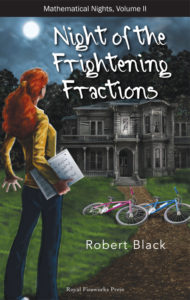Sign in for exclusive products and special discounts.
Mathematical Nights: Math Fiction Series
Lennie Miller finds herself roped into solving bizarre but interesting math problems for a group of mathematically challenged monsters in her new town. But the solutions aren’t always obvious! Lennie runs into plenty of complications along the way, which not only makes for more interesting stories but also illustrates some often-neglected truths about problem solving.
FREE SHIPPING on all prepaid orders! When you purchase the Mathematical Nights set, you can add any other books at the same time and qualify for free shipping on the entire order (in the domestic U.S. only).
In This Series
Description
In the Mathematical Nights books, the heroine, and seventh-grade girl named Lennie Miller, finds herself roped into the role of “Pattern Finder,” solving bizarre but interesting math problems for a group of mathematically challenged monsters who inhabit a realm near her new town. Readers receive all the information needed to solve the problems at the same time Lennie does, and they can try to solve the problems themselves or follow along as Lennie and her friend Gil find the solutions. But the path to those solutions isn’t always the simplest or the most direct one! Lennie runs into complications along the way, which not only makes for more interesting stories but also illustrates some often-neglected truths about problem solving.
The aim of these novels is to present math concepts in a memorable and entertaining way, taking readers through the full experience of mathematical discovery. This combination reflects author Robert Black’s own experience as both a degreed engineer and a writer who has written for kids, beginning with his time on the staff of Nickelodeon’s You Can’t Do That on Television.
Robert Black writes:
“When I started developing my ideas for mathematical fiction, I knew fairly quickly that I didn’t want to take the route of a ‘minute mystery’ type of story, such as the Encyclopedia Brown series. I didn’t want to use a format where the story presents a math problem and then the reader flips the page or goes to the back of the book to find an impersonal narrator explaining how to get the answer. There are a few ‘math mystery’ books like that available—even some good ones—but I wanted to do more. My goal wasn’t just to present mathematical facts and techniques; I wanted to show as much of the problem-solving experience as I could, with all the twists and turns and dead ends and unexpected realizations that come with it. I wanted to do as much as I could to make my readers feel like they’re there solving the problems along with the characters.
Night of the Paranormal Patterns, the first book in the Mathematical Nights series, is also available as a series of dyslexia-friendly books, called the Lennie Miller Dyslexia Series, that incorporates several special features to make it accessible to children with reading difficulties. (See below.)










